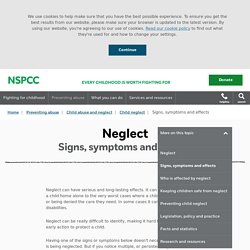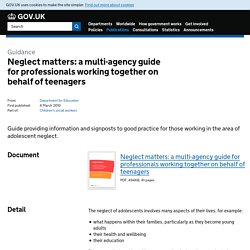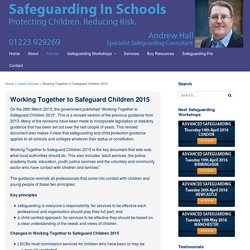

Munro Review. Multi agency working. Commoncore 2010 final 2. Basw 112315 7. Gillen,%20A%2011. MAD01. Dcsf rr023. Elsevier: Article Locator. Signs, symptoms and effects of neglect. The impact of neglect Children who have been neglected may experience short-term and long-term effects that last throughout their life.

Children who don’t get the love and care they need from their parents may find it difficult to maintain healthy relationships with other people later in life, including their own children. Children who have been neglected are more likely to experience mental health problems including depression and post-traumatic stress disorder. Young people may also take risks, such as running away from home, breaking the law, abusing drugs or alcohol, or getting involved in dangerous relationships - putting them at risk from sexual exploitation. Effects on relationships and attachment A parent or carer's behaviour has a big impact on a child.
This relationship, or bond, between a child and their primary caregiver - usually mum or dad but sometimes another family member or carer - is described by attachment theory. (Howe, 2011) Impact of Child Abuse & Neglect - Child Welfare Information Gateway. Learn how child abuse and neglect affect children, adolescents, adult survivors, and society.

This section examines the impact of abuse and neglect on child development, as well as long-term consequences for adults with a history of abuse. Impact is explored by type of abuse, family factors, and the social and economic consequences. Adverse Childhood Experiences (ACE) Response University of Albany & Prevent Child Abuse America Seeks to connect research data and its potential for real-world application to prevent adverse childhood experiences and their consequences through policy and program leadership, community development, and direct practice.
The Adverse Childhood Experiences (ACE) Study. Development and Psychopathology - Resilience among abused and neglected children grown up. Predictors of resilience in abused and neglected children grown-up: the role of individual and neighborhood characteristics. Resiliency in Children and Youth - Child Welfare Information Gateway. Resiliency is defined as the ability to cope and adapt to change.

Being resilient allows children and youth to overcome difficulties in their lives. Resources in this section provide more information about resiliency in children, youth, and families. Bouncing Back: How Can Resilience Be Promoted in Vulnerable Children and Young People? (PDF - 482 KB) Glover (2009) Addresses some of the questions child welfare practitioners in the United Kingdom have about resilience in children, including how it can be defined, nurtured, and measured. The booklet also provides a summary of how resilience fits into child welfare today. Building Resiliency in Child Abuse Organizations Office for Victims of Crime Training and Technical Assistance Center, Office for Victims of Crime, Office of Justice Programs, U.S.
Promoting Children's Mental, Emotional, and Behavioral Health: A Resource for Parents. Predictors%20of%20Resilience%20in%20Maltreated%20and%20Nonmaltreated%20Latino%20Children. Handbook of Early Childhood Intervention. Annual Research Review: Resilient functioning in maltreated children – past, present, and future perspectives - Cicchetti - 2012 - Journal of Child Psychology and Psychiatry. A Review of Developmental Research on Resilience in Maltreated Children. J.

Bart Klika, School of Social Work, University of Washington, 4101 15th Ave NE, Seattle, WA 98105, USA. Email: bklika@uw.edu Abstract Research demonstrates that child maltreatment can negatively impact the psychosocial functioning of individuals well beyond the point at which the trauma occurs. Fortunately, there is evidence that many children who are maltreated succeed in overcoming some of the possible consequences that can follow exposure to this particular form of adversity. Article Notes Declaration of Conflicting Interests The authors declared no potential conflicts of interest with respect to the research, authorship, and/or publication of this article.
Balancing Risk and Protective Factors: How Do Social Workers and Social Work Managers Analyse Referrals that May Indicate Children Are at Risk of Significant Harm. CTF brief 4 abuse neglect risk factors. GetSharedSiteSession?rc=1&redirect= Purpose To identify contextual and interpersonal factors that distinguish families in which the intergenerational transmission of maltreatment is maintained from families in which the cycle is broken.

Methods The sample was composed of 1,116 families in the United Kingdom who participated in the Environmental Risk (E-Risk) Longitudinal Twin Study. Neglect matters: a multi-agency guide for professionals working together on behalf of teenagers. The neglect of adolescents involves many aspects of their lives, for example: what happens within their families, particularly as they become young adults their health and wellbeing their education This means that working with young people who have been neglected inevitably involves more than 1 agency and the expertise of their staff.

There is a need for both agencies and practitioners to work together. GetSharedSiteSession?rc=1&redirect= Figure 1 Survival probabilities for maltreatment perpetration between the ages of 21 and 30 as a function of maltreatment status and level of safe, stable, and nurturing relationships (SSNR).

All control variables held constant at the sample mean. Purpose We examine two research questions. First, does a history of child maltreatment victimization significantly increase the likelihood of maltreatment perpetration during adulthood? Methods Data come from the Rochester Youth Development Study that followed a community sample from age 14 to 31 with 14 assessments.
Results. Breaking the Links in Intergenerational Violence: An Emotional Regulation Perspective - Siegel - 2013 - Family Process. Breaking the cycle of abuse. Child abuse – which has dominated the headlines over the past year as a result of the Savile inquiry and other high-profile child-cruelty cases, and which is often presented as one of the country's most intractable problems – could be reduced by 70% by the year 2030, delegates to a Guardian debate were told.

Plenty of research exists, and more work is being carried out, that shows what could and would lead to a dramatic reduction in the incidence of maltreatment of children. The biggest difficulty is persuading not only decision-makers, but also the public, that preventing child abuse is possible, given the right steps. But what's needed first, participants at the roundtable debate – sponsored by the NSPCC – heard, is a shift in the way the media perceives the problem: too often, one participant remarked, tabloid-newspaper coverage focuses on a witch-hunt and not on the issues that create a culture in which abuse is allowed to continue. Surprising evidence Internet safety At the table. Professional responses to neglect: in the child’s time. Working Together to Safeguard Children 2015. On the 26th March 2015, the government published ‘Working Together to Safeguard Children 2015’.

This is a revised version of the previous guidance from 2013. Many of the revisions have been made to incorporate legislation or statutory guidance that has been set out over the last couple of years. This revised document also makes it clear that safeguarding and child protection guidance applies to all schools and colleges whatever their status or constitution. Working Together to Safeguard Children 2015 is the key document that sets outs what local authorities should do.
This also includes “adult services, the police, academy trusts, education, youth justice services and the voluntary and community sector who have contact with children and families”. Updated guidance for people working with children in England. Working together to safeguard children (HM Government, 2015) is the key statutory guidance for anyone working with children in England.

It sets out how organisations and individuals should work together and how practitioners should conduct the assessment of children. This latest guidance updates the previous version published in 2013. The new version is not a major review, but does include: changes on how to refer allegations of abuse against those who work with childrenclarification of requirements on local authorities to notify serious incidents (where a child dies or is seriously harmed)a definition of serious harm for the purposes of serious case reviews. Read more about the changes on our Policy and guidance section for England. The%20current%20proposals%20to%20revise%20Working%20Together%20are%20seriously%20flawed%20and%20dangerous.
Working Together to Safeguard Children under fire. Working Together to Safeguard Children is too long, cumbersome and unwieldy, say professional bodies and social workers. The criticism came in response to the consultation on a revised version of the government’s key guidance on safeguarding which has now closed. The British Association of Social Workers (BASW) has suggested the guidance be divided into two documents, one a practitioner guide to safeguarding, the other regarding arrangements made by local safeguarding children boards and agencies to safeguard children. The size of the guidance – 300 pages – has alarmed other organisations, including the Local Government Association (LGA). Basw 115513 5. What social workers need to know about new child protection guidance. Given the strong reaction when the then children and families minister, Tim Loughton, first unveiled plans to cut child protection guidance, it is a shame the government did not respond to the consultation before publishing the guidance.
There are political motivations behind this latest announcement. Firstly, the pledge to "cut red tape" echoed findings from social policy expert Prof Eileen Munro, brought in by the education secretary, Michael Gove, to assess the child protection system in England following the death of Baby Peter. Munro found that individuals had become obsessed with maintaining administrative systems rather than being free to "do the right thing" to protect children. Secondly, when Doncaster council produced a heavily redacted serious case review (SCR) after two young brothers were convicted of torturing a nine-year-old and an 11-year-old, Gove ordered Lord Carlile of Berriew to conduct an inquiry. Will the new guidance fundamentally change things for social workers? LSGL01. Impact%20Assessment%20Working%20Together%20to%20Safeguard%20Children. David hoyle - problematizing every child matters. a critique. Contents: introduction · the genesis of every child matters · the evolution of every child matters · ensuring every child matters · critique - the problem of every child matters · conclusion · further reading and references · about the writer · how to cite this piece Every Child Matters was a simple, bold, aspirational statement of policy for children and young people by Her Majesty’s Government (England).
It was formulated in response to a report by Joint Chief Inspectors and the findings of a public inquiry chaired by Lord Laming.